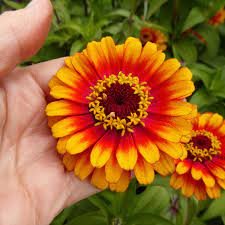**Common Varieties of Chrysanthemums Around the World**

Chrysanthemums, with their diverse colors, shapes, and sizes, are among the most beloved and widely cultivated flowers globally. From ancient China to modern gardens, chrysanthemums have captivated people with their beauty and versatility. Let’s explore some of the common varieties of chrysanthemums found around the world, each with its own unique characteristics and cultural significance.
**1. Single-flowered Chrysanthemums:**
Single-flowered chrysanthemums are characterized by their simple yet elegant appearance, with a solitary row of petals surrounding a central disk. These varieties come in a wide range of colors, including white, yellow, pink, and purple. They are often used in floral arrangements and garden borders due to their versatility and long-lasting blooms.
**2. Pompon Chrysanthemums:**
Pompon chrysanthemums, also known as button or spray chrysanthemums, feature small, densely packed flower heads with tightly clustered petals. Resembling miniature pom-poms, these charming blooms come in a plethora of colors and are popular choices for bouquets, corsages, and floral crafts. Pompon chrysanthemums add texture and visual interest to any arrangement.
**3. Cushion Chrysanthemums:**
Cushion chrysanthemums, named for their rounded, cushion-like flower heads, are prized for their compact growth habit and abundance of blooms. These varieties produce masses of small, daisy-like flowers that cover the entire plant, creating a stunning display of color. Cushion chrysanthemums are ideal for borders, rock gardens, and container planting.
**4. Spider Chrysanthemums:**
Spider chrysanthemums, also known as quill or spider mum, are distinguished by their long, narrow petals that radiate outward from the center, resembling spider legs. These dramatic blooms come in an array of vibrant colors, including orange, red, and bronze. Spider chrysanthemums add a touch of exotic elegance to floral arrangements and garden landscapes.
**5. Anemone-flowered Chrysanthemums:**
Anemone-flowered chrysanthemums feature a unique floral structure characterized by a central dome of tubular disk florets surrounded by a ring of larger, petal-like ray florets. This distinctive appearance resembles that of anemone flowers, hence the name. Anemone-flowered chrysanthemums are prized for their striking appearance and are often used as focal points in floral designs.
**6. Decorative Chrysanthemums:**
Decorative chrysanthemums encompass a wide range of cultivars with elaborate, showy flower heads in various shapes and sizes. These varieties may feature multiple layers of petals, ruffled edges, or unique color patterns, making them highly sought after for special occasions and floral competitions. Decorative chrysanthemums are prized for their beauty and complexity.
**7. Exhibition Chrysanthemums:**
Exhibition chrysanthemums are the pinnacle of chrysanthemum cultivation, meticulously bred and groomed for size, symmetry, and perfection. These varieties often have oversized flower heads with an abundance of petals arranged in precise patterns. Exhibition chrysanthemums are showcased at prestigious flower shows and competitions, where they compete for top honors and accolades.
**Conclusion:**
The diversity of chrysanthemum varieties reflects the flower’s global popularity and cultural significance. From single-flowered classics to elaborate exhibition specimens, chrysanthemums offer endless possibilities for gardeners, florists, and flower enthusiasts. By exploring the unique characteristics of each variety, we gain a deeper appreciation for the beauty and versatility of this beloved flower.
**8. Incurve Chrysanthemums:**
Incurve chrysanthemums, also known as reflex or football mum, are characterized by their tightly packed petals that curve inward toward the center, creating a spherical or dome-like shape. These varieties often feature large, fully double flower heads with a dense, luxurious appearance. Incurve chrysanthemums are popular choices for floral arrangements, corsages, and centerpiece designs due to their striking form and longevity.
**9. Spoon Chrysanthemums:**
Spoon chrysanthemums, as the name suggests, have petals that resemble spoons or spatulas, with a broad base tapering to a pointed tip. These unique blooms add a whimsical touch to bouquets and floral displays, providing visual interest and texture. Spoon chrysanthemums come in a range of colors and are prized for their distinctive appearance and charm.
**10. Brush Chrysanthemums:**
Brush chrysanthemums, also known as spray or daisy chrysanthemums, feature small, daisy-like flowers arranged in loose clusters atop slender stems. These delicate blooms create a profusion of color and texture, making them ideal for filling gaps in floral arrangements or adding a wildflower aesthetic to garden borders. Brush chrysanthemums are cherished for their simplicity and versatility.
**11. Belgian Chrysanthemums:**
Belgian chrysanthemums, bred in Belgium, are renowned for their large, fully double flower heads and rich, vibrant colors. These robust varieties are prized for their excellent vase life and resistance to disease, making them popular choices for cut flower production and commercial floristry. Belgian chrysanthemums are favored by florists and consumers alike for their bold, eye-catching blooms.
**12. Korean Chrysanthemums:**
Korean chrysanthemums, native to Korea, are esteemed for their elegant, graceful appearance and delicate fragrance. These varieties often feature single or semi-double flower heads with a soft, ethereal quality. Korean chrysanthemums are traditionally used in Korean tea ceremonies and cultural rituals, symbolizing purity, tranquility, and longevity. They are also prized for their medicinal properties and are used in traditional Korean medicine.
**13. Thai Chrysanthemums:**
Thai chrysanthemums, cultivated in Thailand, are prized for their exquisite beauty and intricate floral designs. These varieties often feature multiple layers of petals in vibrant colors, arranged in precise patterns reminiscent of traditional Thai art and culture. Thai chrysanthemums are used in religious ceremonies, cultural festivals, and floral competitions, where they symbolize prosperity, auspiciousness, and reverence.
**14. Japanese Chrysanthemums:**
Japanese chrysanthemums, known as “kiku” in Japanese, hold a special place in Japanese culture and history. These varieties are revered for their exquisite beauty, intricate forms, and rich symbolism. Japanese chrysanthemums are prominently featured in traditional tea ceremonies, imperial regalia, and cultural festivals such as the Chrysanthemum Festival (Kiku Matsuri). They are cherished for their elegance, grace, and profound cultural significance.
**15. European Chrysanthemums:**
European chrysanthemums encompass a wide range of cultivars bred and cultivated in Europe, known for their diversity, resilience, and adaptability. These varieties are prized for their vibrant colors, robust growth habits, and long-lasting blooms. European chrysanthemums are popular choices for garden borders, flower beds, and landscaping projects, adding beauty and charm to outdoor spaces throughout the continent.
**Conclusion:**
The global diversity of chrysanthemum varieties reflects the flower’s universal appeal and cultural significance. From classic single-flowered varieties to exotic specimens bred in different regions of the world, chrysanthemums offer endless possibilities for gardeners, florists, and flower enthusiasts. By exploring the unique characteristics of each variety, we gain a deeper appreciation for the beauty, diversity, and cultural heritage of this beloved flower.


